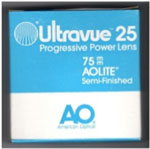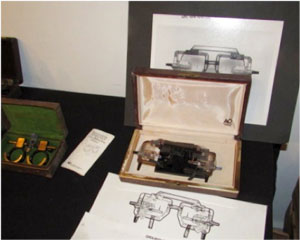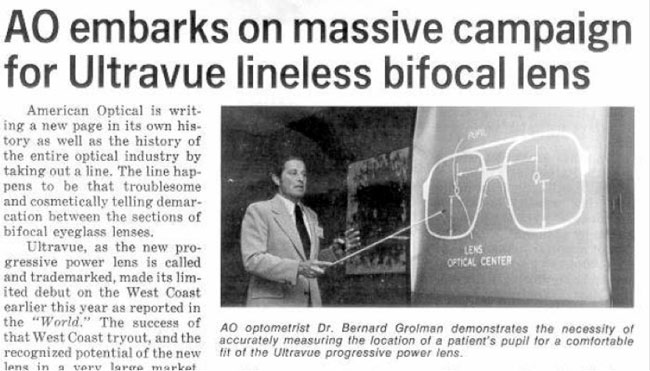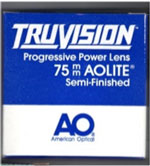The first part of this series on historical American Optical lenses and the Optical Heritage Museum provided an overview of the lenses and information from the 1920s.
This article begins with the American Optical (AO) groundbreaking progressive lens designs released from 1978 forward along with information and insights about each lens.
AO Progressive Lenses
Part Two of this series provides an overview on each of the American Optical progressive lenses from 1978 to 1990 along with my personal insights, lens design background and materials. Part Three of this series will cover the AO progressives from 1990 to present day.

AO progressive lens display at the Optical Heritage Museum

Ultravue 1978 Global Release
American Optical introduced its first Progressive Lens in 1978, and the introduction was indeed a global one. Advertisements appeared on such TV shows as the Today program and Walter Cronkite news. As best as I can determine the design was released for general sale in 1978.
The Ultravue design by today's standards was crude, it was a very "hard" design and was the same for both left and right eyes. By hard, I mean the distribution of unwanted astigmatism/power error was crammed into the lower periphery causing noticeable distortion in these areas. Since the blanks were symmetrical, the lens blanks were rotated by 10 degrees during fabrication to achieve the decentration needed for proper fit in the frame.

At the time of this product line introduction, I was working in the AO Central Testing lab and in charge of optical testing. I measured numerous lenses and production molds for their optical qualities and this experience gave me a good foundation for my career within AO/SOLA/Zeiss.

For this lens, Dr. Bernie Grolman was involved in properly educating on the importance of proper fitting for progressive lenses. It was for this lens the "Grolman fitting device" was introduced (right). The photo on the right shows this device in the museum along with development sketches that were in our files. Dr. Grolman's photo appears in the Ultravue press article on the Ultravue lens introduction (below).


Truvision 1981
American Optical's Truvision lens design was a major advance from the Ultravue, and was the first to employ Dr. John Winthrop's patented design principal of Dirichlet smoothing. This method was used in all subsequent AO Progressive lens designs, and simulated mathematically how nature would distribute powers between poles, much like temperature gradients would be distributed between poles of differing temperatures. To learn more about Truvision and its design, watch this instructive YouTube video that I posted online:
My involvement with this product line occurred when Dr. Winthrop asked me to implement his design in a 1.7 high index glass version when I transferred to R&D in 1983. This was my initial training on Dr. Winthrop's lens design methods and production development oversight, an experience that would serve me well in subsequent years. He was (and is) a great teacher and I will be forever grateful for his patience and skillful training.

OMNI 1988
The OMNI lens was (and likely still is) the "smoothest" progressive lens design ever produced. Unlike the Truvision and Ultravue lenses, which had basically spherical distance portions, OMNI allowed some of the power and astigmatic errors to be smoothly distributed throughout a sizable portion of the distance area. This permitted an unusually low amount of distortion in the reading area where it was usually was contained.
This lens was a first for two areas related to lens processing:
- Because the non-spherical surface of the Distance Portion (DP) area, the lens resulted in automatic prism thinning to occur when blocked and surfaced. Today, most progressive lenses use this feature to produce lenses of equal thickness on the top and bottom of the lens. This was a major design first and one that took a major marketing /educational program to become accepted.
- Because of the non-spherical DP, a shim was required to be placed in the area so the lens would not rock in processing. This too, was a major new development and one which took training and education for laboratories to accept.
Another first at the time of Truvision Progression lens was the introduction of an IBM PC-DOS based computer program, written to help Rx laboratories compute the correct backside curves and thicknesses. This free program titled "AOTVRX" (AO Truvision Rx processing program) was provided free of charge on floppy disks. I had the responsibility for maintaining and upgrading this program in the early 1990s. This program was provided until about 2004. I have had several visitors to the museum who remembered this useful program.












